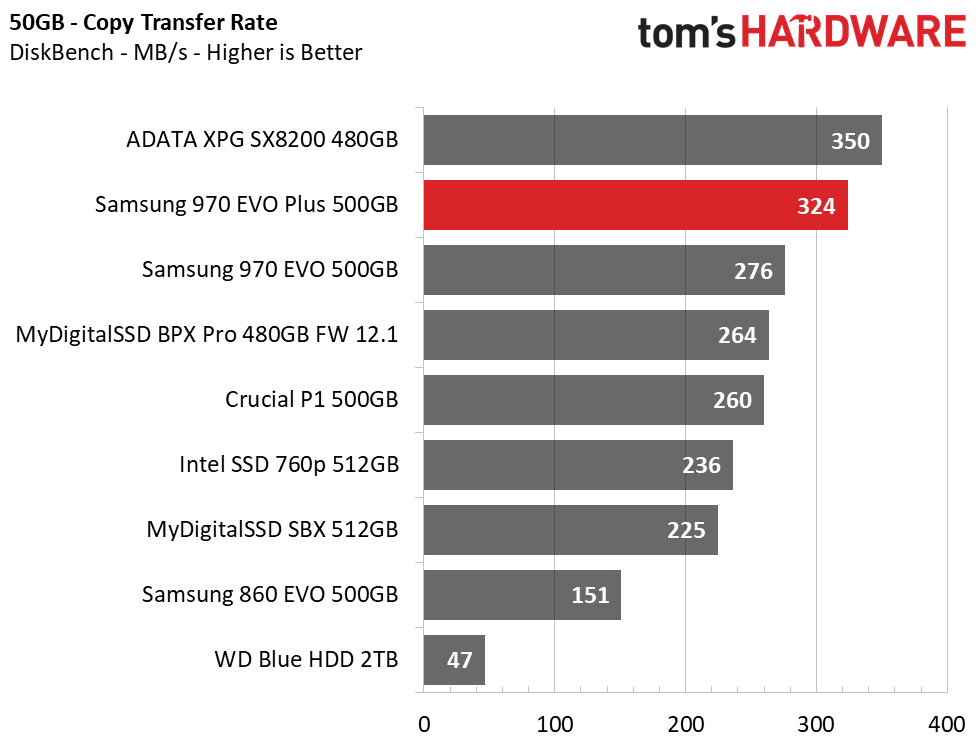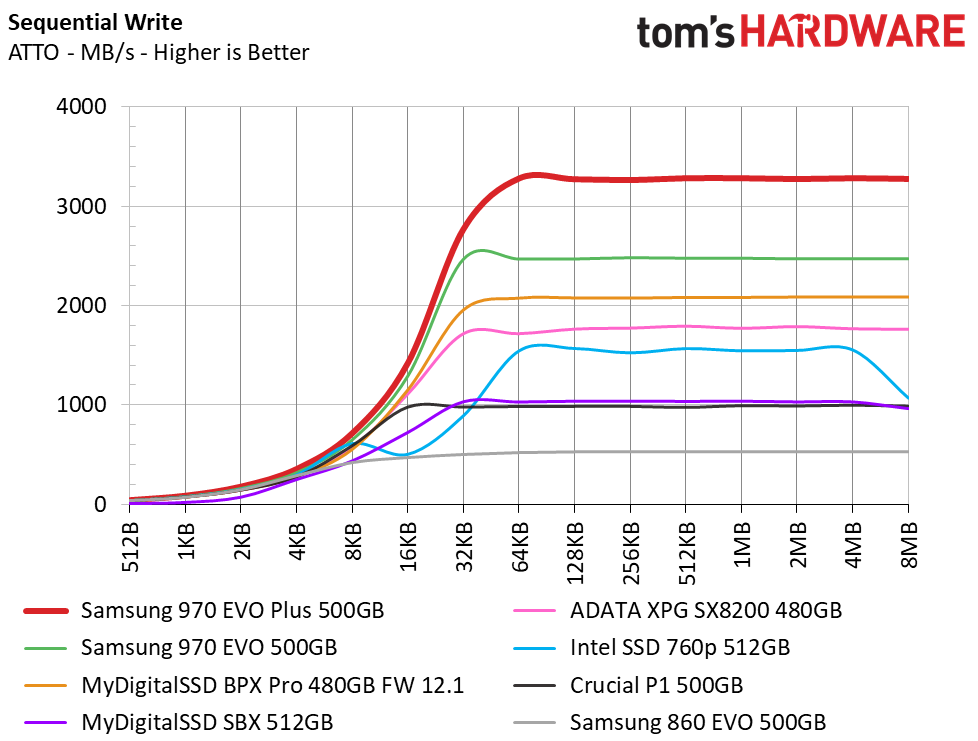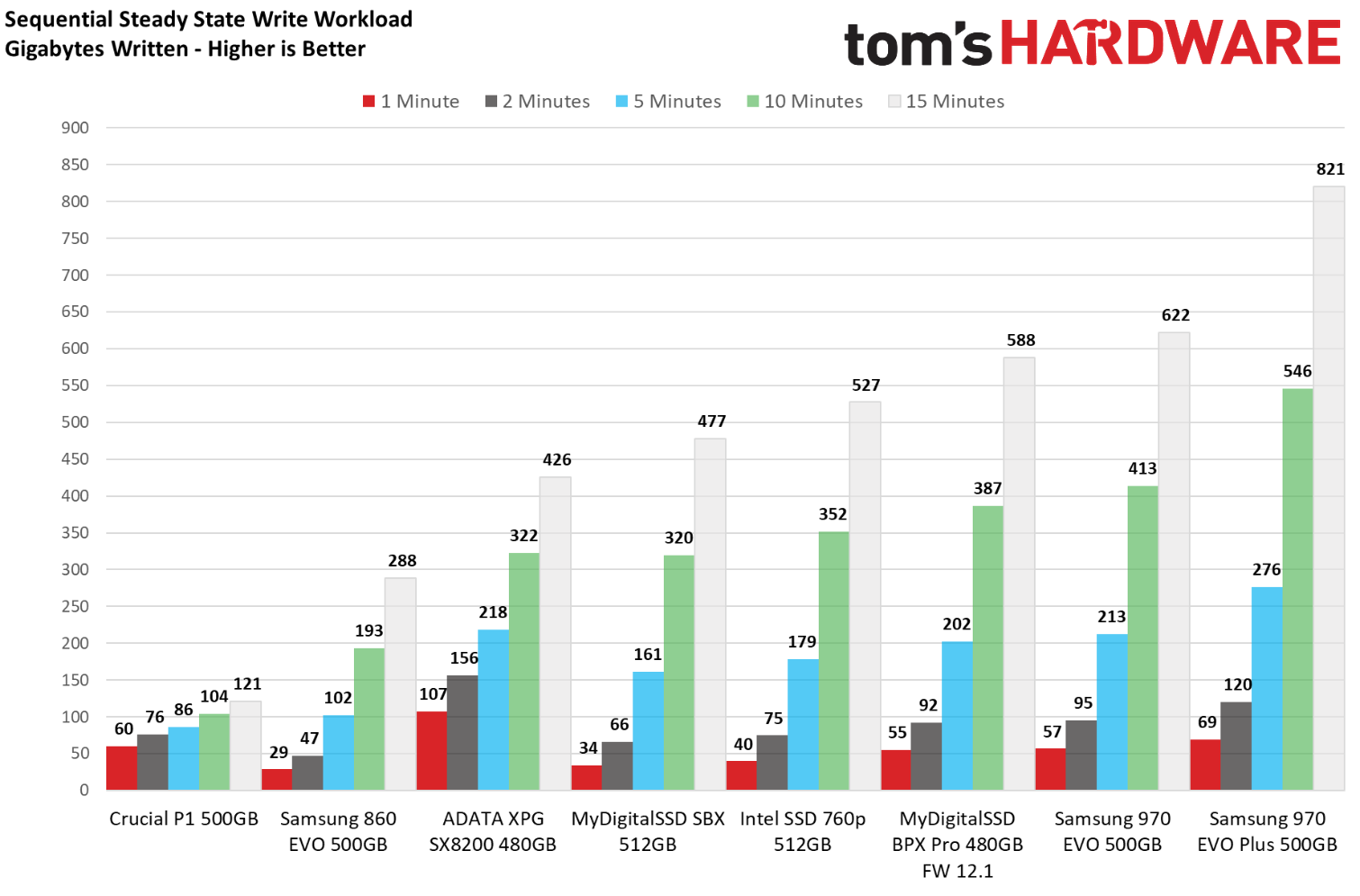Samsung 970 EVO Plus SSD Review: More Layers Brings More Performance
Why you can trust Tom's Hardware
500GB Performance Results
We put Samsung’s 500GB 970 EVO Plus up against the Adata XPG SX8200, Intel SSD 760P, Crucial P1, MyDigitalSSD SBX, and Samsung’s 860 EVO.
Trace Testing – PCMark 8 Storage Test 2.0
PCMark 8 is a trace-based benchmark that uses Microsoft Office, Adobe Creative Suite, World of Warcraft, and Battlefield 3 to measure the performance of storage devices in real-world scenarios.


Performance between the MyDigitalSSD BPX Pro and 970 EVO Plus is very similar, but the BPX Pro's new firmware has given it a slight edge. The 970 EVO Plus beats its predecessor by over 100MB/s during the bandwidth test.
Game Scene Loading - Final Fantasy XIV
The Final Fantasy XIV StormBlood benchmark is a free real-world game benchmark that easily and accurately compares game load times without the inaccuracy of using a stopwatch.
Load times have improved as well. The new 970 EVO Plus beats out the non-Plus by more than a second and the 860 EVO by over two seconds.
Transfer Rates – DiskBench
We use the DiskBench storage benchmarking tool to test file transfer performance with our own custom 50GB block of data. Our data set includes 31,227 files of various types, like pictures, PDFs, and videos. We copy the files to a new folder and then follow up with a read test of a newly-written 6 GB file.


The Adata SX8200 ranks first during the file copy test with a 26 MB/s lead over the 970 EVO Plus. The 970 EVO Plus takes a 50MB/s lead over the 970 EVO, which is a nice step forward.
Get Tom's Hardware's best news and in-depth reviews, straight to your inbox.
The EVO Plus also leads our read performance test, notching a 100 MB/s gain over its predecessor.
SYSmark 2014 SE
Like PCMark, SYSmark uses real applications to measure system performance. SYSmark takes things much further, however. It utilizes fourteen different applications to run real workloads with real data sets to measure how overall system performance impacts the user experience. BAPCo's SYSmark 2014 SE installs a full suite of applications for its tests, which includes Microsoft Office, Google Chrome, Corel WinZip, several Adobe software applications, and GIMP. That also makes it a great test to measure the amount of time it takes to install widely-used programs after you install a fresh operating system.


The 970 EVO Plus installed Sysmark in 894 seconds, which technically ranks in third place behind the BPX Pro and Intel Optane SSD 905P. There's only a three-second gap between the three drives, so the competition is close enough to call a tie.
The 970 EVO Plus beat the other drives in SYSmark's responsiveness score and comes surprisingly close to matching the Optane 905p. We also see a 25-point improvement over the standard 970 EVO. Overall, Samsung's EVO Plus proves to be a snappy drive.
ATTO
ATTO is a simple and free application that SSD vendors commonly use to assign sequential performance specifications to their products. It also gives us insight into how the device handles different file sizes.


The 970 EVO Plus is significantly faster than its predecessor in these synthetic read and write tests. Here the drive hit nearly 3.6GB/s during the read test and 3.3GB/s while writing data. Write performance proves to be the 970 EVO Plus's strong suit: it maintained a huge 1.2GB/s lead over the nearest competitor.
Anvil's Storage Utilities
Anvil's Storage Utility is a commonly-referenced benchmark that simplifies the complex IOMETER benchmark and its underlying Dynamo engine with a one-click software wrapper.



Samsung’s 970 EVO Plus leads during the Anvil’s Storage Utilities testing. Thanks to its blistering write performance and improved read performance, the EVO Plus beats the nearest drive by over 2,600 points.
CrystalDiskMark
CrystalDiskMark (CDM) is a simple and easy to use file size benchmarking tool.












The 970 EVO Plus outperforms the competition during sequential tests, but random read performance is another story. The 970 EVO Plus has been far ahead of the standard 970 EVO in previous tests, but the EVO beats the Plus in the random write tests at a queue depth (QD) of 8. The EVO Plus does eke out a substantial lead over the rest of the test pool during the all-important random write test at QD1, which equates directly to system snappiness.
Samsung rates the 970 EVO Plus’s performance at up to 19K/60K read/write IOPS at QD 1, but we only achieved 13K/47K IOPS in our system with the Meltdown and Spectre firmware and software patches applied.
Sustained Sequential Write Performance
Official write specifications are only part of the performance picture. Most SSD makers implement an SLC cache buffer, which is a fast area of SLC-programmed flash that absorbs incoming data. Sustained write speeds can suffer tremendously once the workload spills outside of the SLC cache and into the "native" TLC or QLC flash. We hammer the SSDs with sequential writes for 15 minutes to measure both the size of the SLC buffer and performance after the buffer is saturated.



As expected, Samsung’s Intelligent TurboWrite runs out after 24GB of data has been written at a rate of 3.1GB/s, then performance degrades to about 850-900MB/s. While this is much lower than the TurboWrite speeds, it is actually much faster than competing products and in line with Samsung’s official specifications.
Power Consumption
We use the Quarch HD Programmable Power Module to gain a deeper understanding of power characteristics. Idle power consumption is a very important aspect to consider, especially if you're looking for a new drive for your laptop. Some SSDs can consume watts of power at idle while better-suited ones sip just milliwatts. Average workload power consumption and max consumption are two other aspects of power consumption, but performance-per-watt is more important. A drive might consume more power during any given workload, but accomplishing a task faster allows the drive to drop into an idle state faster, which ultimately saves power.





New SSDs are becoming more power efficient, and as expected, the Samsung 970 EVO Plus’s efficiency has improved, too. Just not by much.
The EVO Plus's idle power consumption is practically the same as the previous model with both ASPM enabled and disabled. We do see a substantial difference in active power consumption, though. During our 50GB file copy, we see a lower 6.12W maximum result and half a watt less power consumed on average. This represents an impressive 34% improvement in active power consumption!
MORE: Best SSDs
MORE: How We Test HDDs And SSDs
MORE: All SSD Content
Current page: 500GB Performance Results
Prev Page More Layers Brings More Performance Next Page 1TB Performance Results
Sean is a Contributing Editor at Tom’s Hardware US, covering storage hardware.
-
Talwyn Wize I do wish you'd compared it to the 960, though, so we could see the improvement in comparison to its previous generation.Reply -
seanwebster Reply21702521 said:I do wish you'd compared it to the 960, though, so we could see the improvement in comparison to its previous generation.
21702550 said:And the 970 Pro.
Unfortunately, I do not have access to either. I did get to borrow a 1TB 970 PRO temporarily for testing, so that is included, but not the 512GB model. -
TCA_ChinChin I've heard from some other sources that it's faster than the 970 pro (in some cases?).Reply -
seanwebster Reply
Check out the 1TB charts on the third page of the review. In the 50GB copy and 6GB read tests, SYSmark, and game load test it out performs it.21702700 said:I've heard from some other sources that it's faster than the 970 pro (in some cases?).
As end products both the 970 EVO and EVO Plus feature the same exact endurance rating. They have been using TLC in the EVO line up for years now.21702858 said:So, Samsung too has switched to the lower-endurance TLC...
-
mac_angel I'm curious if they've made it compatible with PCIe gen 4 with a firmware upgrade. Little odd to be coming out with a PCIe gen3 product when the gen 4 was ratified last summer.Reply -
mdd1963 sticking with my 960 EVO for the life of the rig, as it is only 2 years old and counting...Reply -
ArmadaCas Does anyone know if this SAMSUNG 970 EVO PLUS (1TB) will run in an ASUS Z170 Pro Gaming with an i7 6700k..? The documentation for the mobo mentions M.2, but not NVME, so I'm kinda lost.Reply



